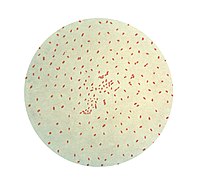
Photo from wikipedia
This report provides evidence for motility and expression of flagella by B. pertussis, a bacterium that has been reported as nonmotile since it was first isolated and studied. As with… Click to show full abstract
This report provides evidence for motility and expression of flagella by B. pertussis, a bacterium that has been reported as nonmotile since it was first isolated and studied. As with B. bronchiseptica, B. pertussis cells can express and assemble a flagellum-like structure on their surface, which in other organisms has been implicated in several important processes that occur in vivo. The discovery that B. pertussis is motile raises many questions, including those regarding the mechanisms of regulation for flagellar gene and protein expression and, importantly, the role of flagella during infection. This novel observation provides a foundation for further study of Bordetella flagella and motility in the contexts of infection and transmission. ABSTRACT Bordetella bronchiseptica encodes and expresses a flagellar apparatus. In contrast, Bordetella pertussis, the causative agent of whooping cough, has historically been described as a nonmotile and nonflagellated organism. The previous statements that B. pertussis was a nonmotile organism were consistent with a stop codon located in the flagellar biosynthesis gene, flhA, discovered when the B. pertussis Tohama I genome was sequenced and analyzed by Parkhill et al. in 2003 (J. Parkhill, M. Sebaihia, A. Preston, L. D. Murphy, et al., Nat Genet, 35:32–40, 2003, https://doi.org/10.1038/ng1227). The stop codon has subsequently been found in all annotated genomes. Parkhill et al. also showed, however, that B. pertussis contains all genetic material required for flagellar synthesis and function. We and others have determined by various transcriptomic analyses that these flagellar genes are differentially regulated under a variety of B. pertussis growth conditions. In light of these data, we tested for B. pertussis motility and found that both laboratory-adapted strains and clinical isolates can be motile. Upon isolation of motile B. pertussis, we discovered flagellum-like structures on the surface of the bacteria. B. pertussis motility appears to occur primarily in the Bvg(−) phase, consistent with regulation present in B. bronchiseptica. Motility can also be induced by the presence of fetal bovine serum. These observations demonstrate that B. pertussis can express flagellum-like structures, and although it remains to be determined if B. pertussis expresses flagella during infection or if motility and/or flagella play roles during the cycle of infection and transmission, it is clear that these data warrant further investigation. IMPORTANCE This report provides evidence for motility and expression of flagella by B. pertussis, a bacterium that has been reported as nonmotile since it was first isolated and studied. As with B. bronchiseptica, B. pertussis cells can express and assemble a flagellum-like structure on their surface, which in other organisms has been implicated in several important processes that occur in vivo. The discovery that B. pertussis is motile raises many questions, including those regarding the mechanisms of regulation for flagellar gene and protein expression and, importantly, the role of flagella during infection. This novel observation provides a foundation for further study of Bordetella flagella and motility in the contexts of infection and transmission.
Journal Title: mBio
Year Published: 2019
Link to full text (if available)
Share on Social Media: Sign Up to like & get
recommendations!